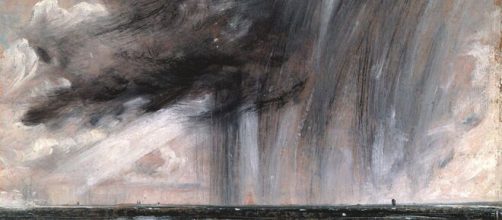Who did what first in art is a knotty question with an undependable answer. According to the history books, when it comes to abstract painting, Wassily Kandinsky was the pioneer with an untitled work in 1910.
Stormy weather
But it can be argued that John Constable was the first abstract artist when in 1824, he quit painting what he saw and pictured what he felt about what he saw. Consider "Seascape Study with Rain Cloud" full of lashing, thrashing brushwork to put into paint an exploding storm at sea.
While departing from representation, with only a slight suggestion of ocean and shore, the painting is not about these things.
Instead, it describes the forces behind them – their propulsion.
"Seascape Study with Rain Cloud" is part of an exhibit titled “Late Constable,” pictures he made toward the end of his life, now at the Royal Academy, London through February. And the way that Jonathan Jones, The Guardian’s veteran art critic reviewed it, you know the image is as good as it looks in a photograph.
Jones calls the brushstrokes so “volcanic” that they put Turner (JMW) in the shadows and “recasts John Constable as the godfather of the Avant-Garde.” The Turner putdown is huge given that he saw his work at Tate Britain last year as “heart-stopping,” as well as “a roaring, wondrous whirlpool of a show.”
In case you think it’s unfair to evaluate the work of an artist by comparing it to another, it’s best to remember that Turner also painted stormy seascapes that allowed him the same freedom to bounce color around as unreservedly as Jackson Pollock.
Purple prose
Jones hailed Turner’s visions of the sea as so stirring that he felt “criminally tempted to touch the surfaces.” With such effusiveness, you don’t expect him to cast Turner in the shade on seeing the Constable exhibit. You’re left puzzled until you remember something else Jones said about the Turner show last year.
Referring to Turner’s famous 1840 painting The Slave Ship, also known as Slavers Throwing overboard the Dead and Dying—Typhon coming on, Jones hailed it as an “erotically-charged shipwreck.” That’s when you realize that Jones’ Tate Britain review was bombast.
Jones also called The Slave Ship a “sexy shipwreck.” Never mind that this was an actual event in 1781 when the vessel’s drinking water was in short supply and to conserve it, the captain tossed 132 slaves into the icy Atlantic.
If Jones can call Turner’s vision of horror sexy, you know to disregard him elevating Constable over Turner. There may be a moral to this story: art criticism is not gospel. That said, Jone's conclusion in his review of Constable’s "Seascape Study with Rain Cloud" is irrefutable.
He said that the two giant arcs that slice through the air and plunge to the stones below “have no origin in the natural world: they have come from inside the painter.” And there you have it: Constable the abstract painter giving birth to modern art.


